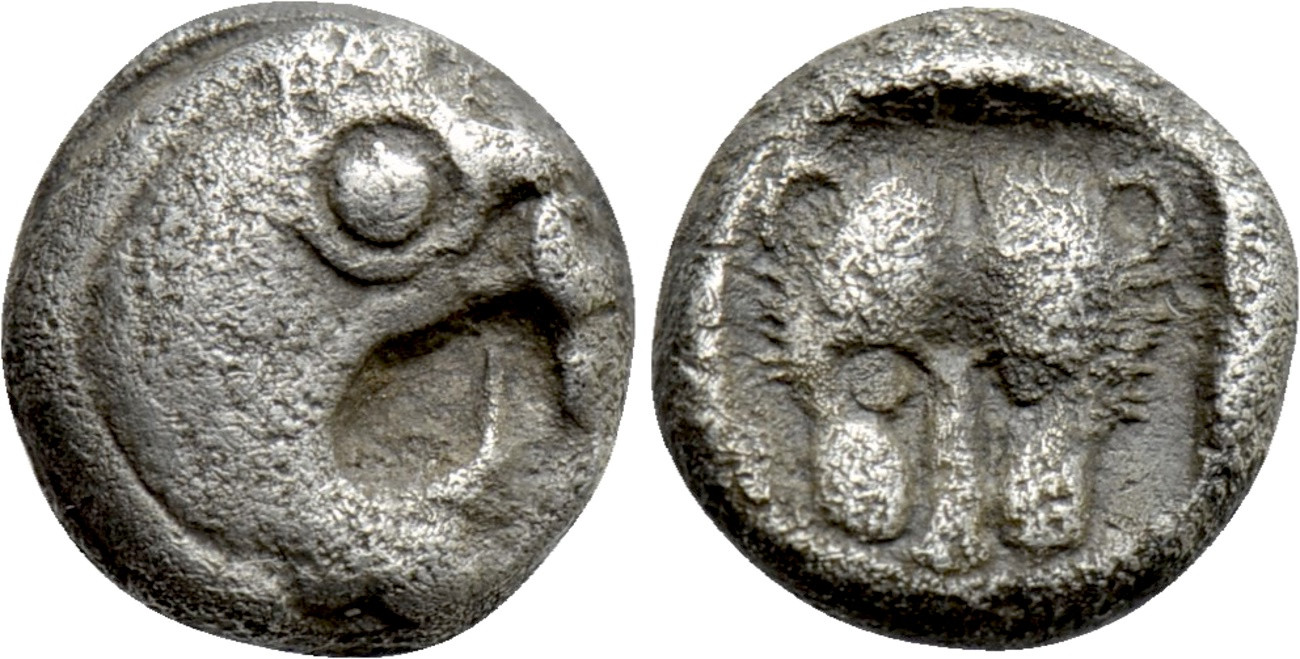Caria (uncertain mint), silver, obols (griffin/panther) (460-440 BCE)
From SILVER
460 BCE - 440 BCE Silver 105 kg
Description
| ObverseInscription or printing placed on the obverse.: | Stylised head of griffin right. |
| ReverseInscription or printing placed on the reverse.: | Facing panther's head within incuse square. |
Mint and issuing power
| MintIdentifies the place of manufacture or issue of a numismatic object.: | Caria (uncertain mint) | Ancient regionAncient region.: | Caria | Modern countryModern country: Turkey | AuthorityIdentifies the issuing power. The authority can be "pretended" when the name or the portrait of X is on the coin but he/she was not the issuing power. It can also be "uncertain" when there is no mention of X on the coin but he/she was the issuing power according to the historical sources: |
Chronology
| FromIdentifies the initial date in a range assigned in a numismatic context. | 460 BCE | toIdentifies the final date in a range assigned in a numismatic context.. | 440 BCE | PeriodTime period of the numismatic object.: Classical 480-323 BC |
Physical description
| MetalThe physical material (usually metal) from which an object is made.: | Silver |
Median weightMedian of the weights of numismatic objects (in grams). in grams | 0.65 | DenominationTerm indicating the value of a numismatic object. Examples: tetradrachm, chalkous, denarius.: | obol |
StandardStandard.: | Aeginetic |
Image

S1611 Caria Obols Monster.jpg [1]
References
| Die study referencePublication of the study: | Fischer-Bossert 20201Fischer-Bossert 2020, p. 150-152, n° 40-52 | ||
| Coin series referenceReference to coin series study: | |||
| Coin series web referenceCoin series web references: | |||
Obverse dies distribution
| FrequencyFrequency of specimen in distribution. ᵖ | Number of obversesNumber of obverse dies. ᵖ (o) | % (o) | Number of coinsNumber of coins. (n) | % (n) | Die nameName(s) of the die(s). |
| 2 | 4 | 66.67 | 8 | 50 | 18, 19, 21, 22 |
| 4 | 2 | 33.33 | 8 | 50 | 17, 20 |
| Total | 6 of 6 | 100 | 16 of 16 | 100 |
Reverse dies distribution
no distribution is available
Quantification
| Number of obversesNumber of obverse dies. ᵖ (o) | 6 | Number of singletons (o1)The number of singleton coins. ᵖ | 0 |
| Number of reverse diesNumber of reverse dies. (r) | 10 | Number of coinsNumber of coins. (n) | 16 |
| Coins per obverse dieNumber of coins per obverse die. (n/o) | 2.67 | Coins per reverse dieNumber of coins per reverse die. (n/r) | 1.6 |
| Reverse per obverse ratioRatio of obverse dies divided by reverse dies. (r/o) | 1.67 | Percentage of singletons (o1)number of coins (n) divided by the number of singletons (o1) ᵖ | 0 % |
| Original number of dies (O) (Carter 1983 formula)The estimation of the number of coins according to Carter 1983 ᵖ | 8.08 | Coins struck if 20,000 as average productivity per dieCoins made if the average productivity for obverses (according to Carter) is 20,000. ᵖ | 161,600 |
| Original number of dies (O) (Esty 2011 formula)The estimation of the number of coins according to the singleton formula in Esty 2011 ᵖ (O) | 9.6 | Survival rate if 20,000 as average productivity per dieSurvival rate if average productivity is 20,000. ᵖ | 0.00010 |
| Coverage (o = % of O) (Esty 1984 formula)Esty 1984 - coverage (% of O) ᵖ (o = % of O) | 100% | Die productivity if survival rate 1/2,000Average productivity if survival rate is 1/2,000. ᵖ | 3,960.4 |
| Weight of silver (in kg) if 20,000 coins per die (O = Carter formula)Carter 1983 * Median weight * 20000 (*10 if gold or electrum) ᵖ | 105 kg <br /> 105 kg | Die productivity if survival rate 1/5,000Average productivity if survival rate is 1/5,000. ᵖ | 9,900.99 |
Remarks
Most likely one single workstation Several reverse dies (11, 12 and 15) shared with other obols of the uncertain mint in Caria
References
- ^ Fischer-Bossert, Wolfgang (2020), "Ein karisches Monster", in M. Baer, W. Fischer-Bossert and N. Schindel (eds), Cista mystica. Festschrift für Wolfgang Szaivert, Vienna, p. 119–168.